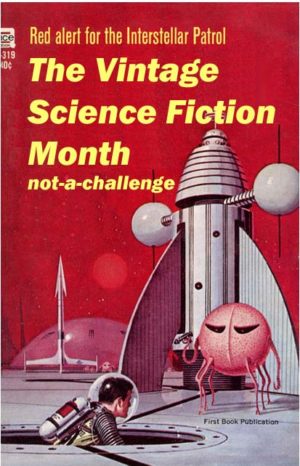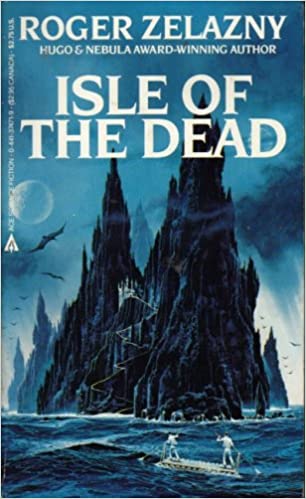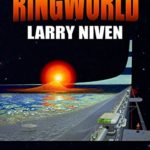Every January is Vintage Science Fiction Month, the not-a-challenge created by Andrea at the little red reviewer and Retro Rockets podcast as well as Red Star Reviews. It’s definitely one of my favorite scifi celebrations. The original idea was to comment on science fiction written before your birth year – but I believe “vintage” came to mean before 1979. For my last contribution to this year’s not-a-challenge, I decided to delve for the first time into the work of Roger Zelazny. It’s just as brilliant as everyone says, and the first book of his I read, Isle of the Dead, is the one I picked for this review. It may not be as famous as the Lords of Amber series, but it is a classic, and left me wishing for far more books featuring the central character of Francis Sandow. There is one more that I know of in which he plays a minor role – To Die in Italbar, and one short story, but Isle of the Dead is the major work with Sandow as the central character, and it’s a gem.
Zelazny begins the story with Sandow’s strong narrative voice that reminded me of one of Dashiel Hammet’s hardboiled detectives. But that voice works through a complicated opening picture, as well as a punchy verbal style. He describes a version of Tokyo Bay as an image of the ebb and flow of life. The bay collects all the flotsam and wreckage of the world, but also beautiful things that sweep in on the tides. Then the tides recede, and good and bad alike are swept out to sea. He is at once cynical, world-weary and sensitive to the good things life can bring you amid the trash – even if they are washed away again by time, or the tides of Tokyo Bay.
Frank Sandow is an ultra-wealthy worldscaper, someone who developed the ability after long apprenticeship, to fashion planets to order. This has not only made him one of the richest men in the galaxy but also the possessor of a dozen or so worlds of his own. Homefree is the one he lives on most of the time, and it is there, amid his perfectly tailored sunsets, meals prepared by a great Rigelian chef, his intimacy needs answered by a highly paid courtesan, that he receives a series of disturbing messages. These come in the form of pictures of people he once knew who are long dead, in some cases centuries dead. That is possible because Sandow, thanks to having been in cryo-sleep for hundreds of years during interstellar voyages before the advent of faster than light travel, is the last survivor of the twentieth century in the third millenium. He has also preserved a younger body through special medications.
A different message arrives from one of the most important people in his life, a Pei’an, who mentored him through a thirty-year training that not only instilled the power of telepathy but also confirmed him in the name of one of the Pei’an gods. That god is Shimbo, shrugger of thunder, the only Pei’an god to have a human form. The Pei’ans are described as green, seven feet tall with funnel shaped heads, flat on top with a narrow neck. His mentor, Marling, is dying and promises to reveal who is sending him the cryptic messages if he will accompany him in the ritual of death. This involves the two of them entering a journey into a dreamworld from which only one returns to the land of the living. Sandow agrees and learns that another Pei’an, named Gringrin, has been preparing an elaborate revenge for years simply because Sandow had been able to complete the ritual of Naming, and the Pei’an had not.
Pei’ans are famous for nurturing for many years their complex schemes of vengeance, and there is no escaping the multiple traps that Gringrin has set for Sandow. So he must travel to one of the worlds he created, called Illyria, to confront and destroy the enemy he has never met. That Gringrin has chosen Illyria seems strange to Sandow since every living thing there is his creation and should help him on his way. The specific location he heads for is an island on a lake fashioned after Boeklin’s famous paintings of the Isle of the Dead.
I’ve read that Zelazny wanted to use a pared down style, in the manner of Hemingway, in this book, but his natural gift of evoking fantastical landscapes and his love of mythological figures of many traditions keeps taking over.
“Isles of coral would appear in sudden deserts of purple and orange, as the waters rolled back, humped up, became a green mountain, moved round the world; and stones and bones and fishes and driftwood would lie like the footprints of Proteus, and the winds would follow, and the temperature-shifts, the inversions, the fields in the clouds, the cathedrals in the sky; and then the rains would come, and the wet mountains would break themselves upon the land, as the fairy cities shattered and the magic isles returned to the depths and Proteus, God knows where, would laugh like thunder, as with each bright flash Neptune’s whitehot trident dipped, sizzled, dipped, sizzled. Afterwards, you’d rub your eyes.”
Isle of the Dead, Kindle edition, page 317, Location 3919
Isle of the Dead is carefully constructed and, despite the sometimes lush language, moves toward its climax with no wasted motion. Zelazny evokes characters, landscape and complex fight scenes in swift strokes that always hit the mark. He’s quickly become one of my favorite writers – too bad I didn’t get to him sooner.






Leave a Reply